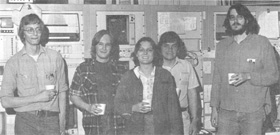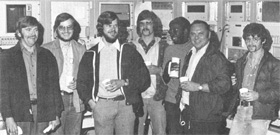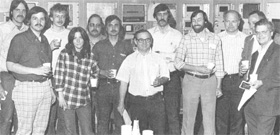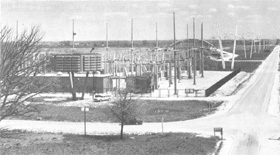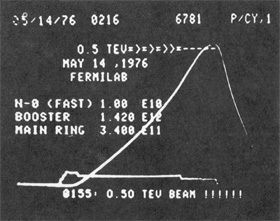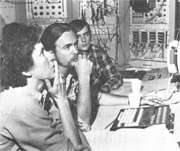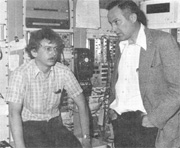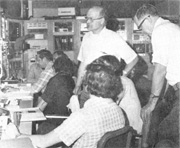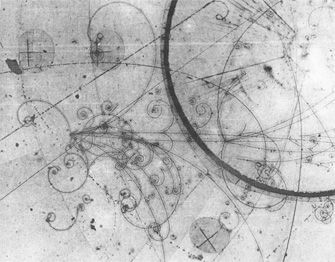Fermilab Accelerator Reaches 500 BeV Energy
A three-day contest between the skilled people at Fermilab and the giant machine they have built ended at 1:15 a.m. on Friday, May 14, when the Fermilab accelerator's energy was pushed for the first time to 500 billion electron volts. The epic event produced the highest energy protons ever recorded in a man-made machine and keeps the Fermilab accelerator in top position as the highest energy machine in the world. Two experiments went into action immediately to record experimental data at the extraordinary energies.
The try for the new energy level began on the afternoon of Tuesday, May 11. Since July 21, 1975 the normal operating energy level of the accelerator has been 400 BeV. A 30-minute foray to 450 BeV in 1975 and another preliminary test at 474 BeV on April 14, 1976 gave the crews of the Accelerator Division a brief but important background for the exercise, conducted during a scheduled three-day maintenance and repair period.
By 5:30 p.m. on Tuesday, the accelerator was running comfortably at 450 BeV. At 7:30 p.m. the magnet ramp (setting the stage for the beam to follow) was set at 480 BeV. It was here that the Accelerator Division's challenge began.
Tuesday evening was the night Jim Hogan's power supply experts hustled from one service building to another around the Main Ring. Keeping in constant touch with the Main Control Room by intercom, the seven-man crew adjusted, replaced, and corrected the faults that cropped up as the 60 Main Ring power supplies were pressed into the new energy mode.
Meanwhile, back in the control room, Howie Pfeffer guided and coaxed the new capacitor tree into its full-scale launching as part of the accelerator system. For months, Pfeffer and his crew had modified and rebuilt the cap tree that will keep the power supplies from sagging under the high currents necessary for 500 BeV. The striking blue and orange device is located at one side of the Master Substation, near the new transformer installed last July, more than ½ mile from the Main Control Room.
The power supply adjustments and the cap tree observations, while intense and demanding on the crews for a time, were fruitful in the end on Tuesday night. Operation became stable enough that Experiment #321 in the Internal Target Area could turn on its equipment and record the experimental data at 450 BeV. Working alongside the machine operators, the switchyard group paved the way for the protons to be extracted from the Main Ring to the external experimental areas. Beam was seen as far as the Proton Area that night.
With the experience of the first night behind them the crews brought the accelerator on easily at 450 BeV on Wednesday at 5:00 p.m. for the next session. Within two hours a 480 ramp was running. The wrestling between people and machine went on again all night, with success just beyond their finger tips as they reached 492 BeV about 7 a.m.
Thursday morning, it was decided to modify the tune of the accelerator when the tests resumed that night. By reducing the tune of the machine, less current was required in the quadrupole magnets and it then became possible to achieve the 500 BeV level.
By midnight Thursday this new routine was stable, the machine was ready to learn the new program. At 1:30 a.m. 497 BeV was in sight. Howie Pfeffer made one final adjustment in the computerized program and at 1:51 every monitor in the Laboratory could flash a victorious 500 BeV energy!
Not content with this as the ultimate victory, the Accelerator Division announced the achievement as 0.5 TeV, the language of the future. (T is for Tera, a million-million.)
There was a short pause for champagne in the Main Control Room. Within an hour, there was concentration again to get the beam to the Neutrino Area and to the 15 ft. Bubble Chamber. Experiment #172 (a collaboration of the Universities of California, Hawaii, and Washington, and the Lawrence Berkeley Laboratory) began taking pictures in the chamber about 3:30 a.m. Prints of the experiment's test strip, showing a neutrino interaction with 500 BeV beam in a neon-hydrogen mixture, were available around the Laboratory at 9:00 a.m. Friday morning for the Annual Users Meeting.
The Columbia-Stony Brook collaboration (Experiment #321), in the Internal Target Area, also recorded 500 BeV data from 4:00 a.m. to 8:40 a.m. on May 14. This experimental group immediately submitted a proposal for an experiment at 1 T (1000 BeV).
The giant accelerator, once tamed and trained, ran continuously and without further complication at 500 BeV for nearly six hours.
Russ Huson, Deputy Head of the Accelerator Division, commented at the end of the mission, "Many, many people contributed to the success of achieving 500 BeV in the accelerator They can all be proud of their individual contributions as well as the performance of the machine.
"We are all particularly grateful to Howie Pfeffer for his skill and dedication in preparing the capacitor tree and the power supplies.
According to Huson, it should be possible to schedule running for experiments at 450 BeV next fall and at 500 BeV in the spring of 1977. Additional work will be carried out on the capacitor tree and in the power supplies.

